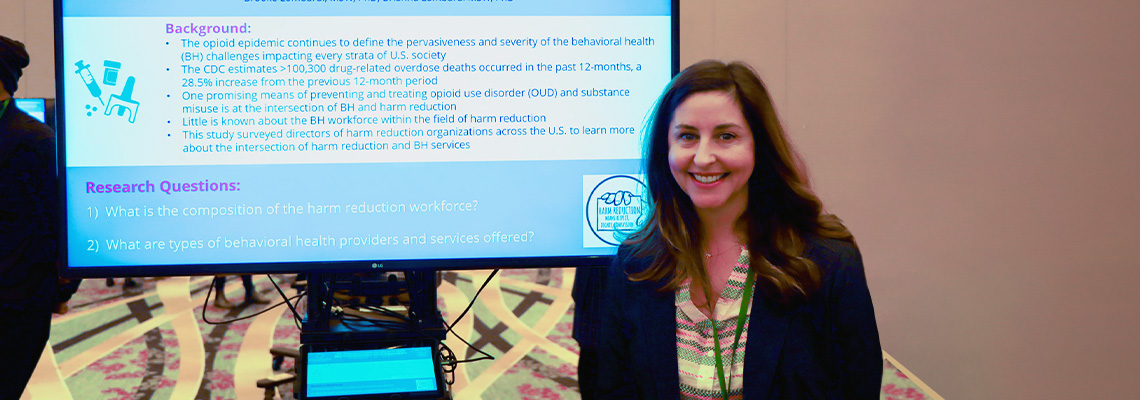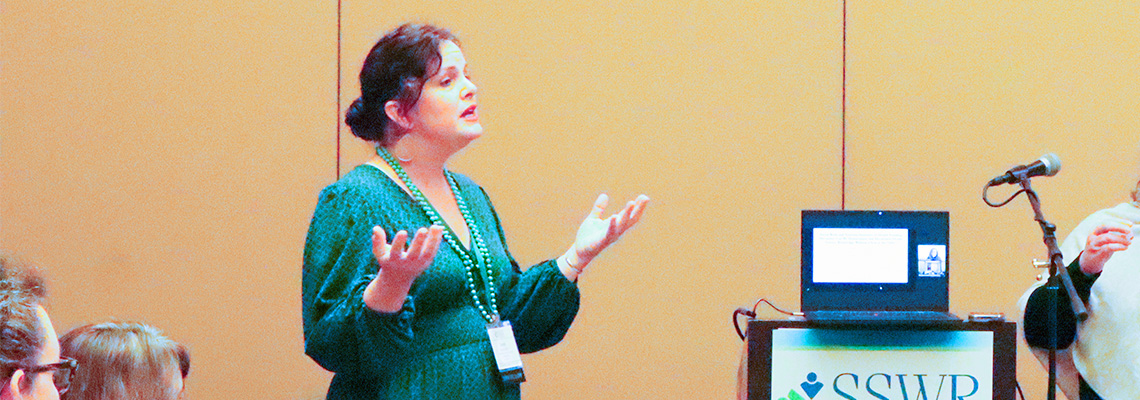by Matthew Smith
Researchers are not only interested in learning about the “why” behind public health issues, but the “who” as well.
A University of North Carolina at Chapel Hill School of Social Work team led by Associate Professor and Deputy Director for the UNC Behavioral Health Workforce Research Center (UNC BHWRC) Lisa de Saxe Zerden sought to understand the who of the harm reduction workforce in association with the ongoing opioid epidemic. The team also included Research Assistant Professor and UNC BHWRC Director Brianna Lombardi, Assistant Professor Orrin Ware, and Research Associate and alum Brooke Lombardi.
Zerden presented her findings, “The Behavioral Health Workforce in Harm Reduction Community Based Organizations,” at the 28th annual Society for Social Work and Research Conference in Washington, D.C.
“We know that the harm reduction field has really expanded in terms of federal dollars and investments,” Zerden said. “This study assessed who is part of the behavioral health workforce in harm reduction services. Who are the people that are helping refer people who use opioids to services? Who is helping to get them into treatment, and who is connecting them to the community?”
Harm reduction refers to a range of practices and policies developed to lessen the negative consequences associated with drug use. The workforce within harm reduction organizations is vast. Among those who provide behavioral health services, the workforce includes peer support specialists, care coordinators, clinical social workers and more.
Zerden and her team collected data from across the country from community-based syringe service organizations registered on a national directory. In total, the team heard back from more than 150 organizations. They examined organization characteristics, their workers providing behavioral health services, the types of services being delivered, and the referral process within harm reduction organizations.
“We were able to do a national survey that included executive directors and leaders at syringe service programs to find out who works in their organizations, what are their hiring challenges, and what can we do to better support this workforce that’s only going to continue to grow and expand,” Zerden said.
The results from the survey provided a glimpse into the behavioral health services provided across the country and the wide range of behavioral health services offered.
“I think we were surprised about how many organizations talked about having behavioral health support, but the variation of who provided that support ranged from peer support providers to master’s-level trained providers,” Zerden said. “It just shows you the breadth of the behavioral health workforce and the scope of practice really varies.”
The study found that behavioral health made up the smallest portion of services offered by harm reduction organizations and that clinical social workers made up less than 10% of the behavioral health workforce within harm reduction organizations.
Zerden added that findings from the study highlight the need for harm reduction organizations to bolster the behavioral health workforce, especially social workers, because of their ability to perform multiple functions, including behavioral health screenings, assessments and integration of evidence-based models of care.
“We also know that there is no national licensure or certification needed to work in harm reduction,” she said. “There’s a lot of variability for the training and preparation in these organizations. Because there has been a huge infusion of federal dollars — including $30 million from the Substance Abuse and Mental Health Service Administration — we’re going to need to understand who we’re giving these funds to, how are they trained, and how are they staffed up.”
Increasing the workforce within the field could also expand services to specialty mental health care.
“Finding ways to think about how health departments and other non-profits can work with community-based harm reduction organizations is the biggest takeaway,” Zerden said. “We have to prepare the future workforce for the practice realities and harm reduction service delivery is a key aspect of this work.”







